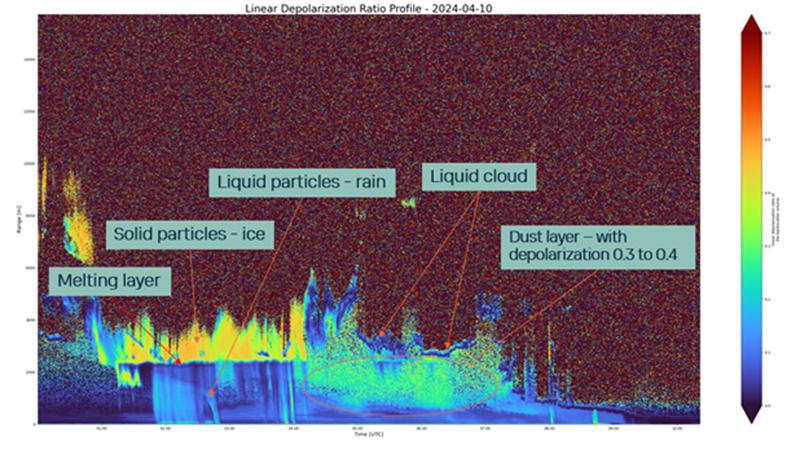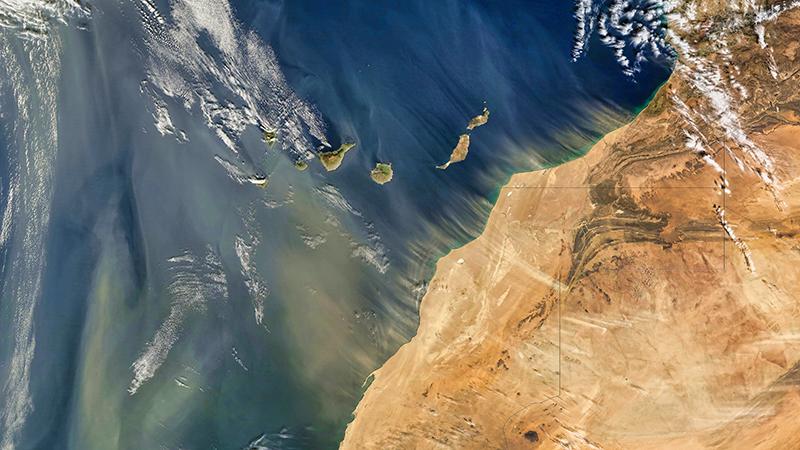Unveiling the Saharan dust outbreak: Insights from Ceilometer CL61
This past April, an unexpected visitor graced the skies above Europe — Saharan dust. Carried by atmospheric winds, these light dust layers traveled across continents all the way to the northern reaches of Scandinavia. Today, we unravel the dynamics of this phenomenon using our cutting-edge Vaisala Ceilometer CL61.

This satellite image shows the Saharan dust layers in high concentrations above Finland.
Winds carry dust from the Saharan Desert in seasonal patterns around the world. Depending on the level of concentration, this Particulate Matter (PM) affects air quality like other forms of pollution and is important to detect for protecting public health.
Peering into the atmosphere
On April 10, 2024, CL61 detected the Saharan dust with exceptional accuracy.
The ceilometer has been positioned in the middle of Finland, serving as our sentinel where it captures essential data on atmospheric particles. Its unique depolarization measurement capability allows us to discern the nature of particles like dust, ice and even volcanic ash (read more about depolarization here)
The ability to detect airborne particles is essential for meteorology, aviation, and urban & industrial applications. The dust is invisible in lower concentrations, but the revolutionary Ceilometer CL61 can reveal even the smallest quantities. CL61 is the first of its kind to combine standard ceilometer measurements with advanced depolarization and particle differentiation.
Visualizing the data
CL61’s powerful visualization tools make it easy to identify the movement and concentration of particles over time (read left to right, with time stamps) as seen in the following images. The first one shows something in the air that could be guessed to be Saharan dust. The second image verifies this with depolarization values of 0.3 to 0.4, which corresponds to literature values of sand.
The first image we examine is the attenuated backscatter profile. Here's what we learn from it:
- Nighttime precipitation: The precipitation events are evident in the profile during the night.
- Melting layer: At 2200 meters, we encounter the 0° C temperature level — the transition zone where ice becomes liquid.
- Saharan dust layer: The precipitation ends around 4:00 a.m., revealing an aerosol layer aloft — the Saharan dust signature.

The second image shows the depolarization ratio. By analyzing the polarization state of the backscattered light, we gain valuable information:
- Precipitation phase transition: The depolarization ratio reveals that the nighttime precipitation originated from solid cloud particles (ice). As the precipitation descended, it underwent a phase change to liquid at the melting layer.
- Saharan dust confirmed: The aerosol layer exhibits depolarization values consistent with sand or dust particles (0.3 to 0.4). Drawing from Saharan dust outbreak data, we confidently attribute this layer to Saharan dust transport.

More than a ceilometer
The Ceilometer CL61 offers a deeper understanding of atmospheric processes with its unique ability to analyze both cloud data and depolarization. Standard ceilometers cannot measure the height and thickness of a layer of dust, but CL61 provides a clear picture with visualization of the vertical profiles.
By integrating these capabilities, we gain actionable information about the concentration and movement of particles in the air.
Beyond just measuring cloud heights, CL61 serves as a celestial investigator by providing a more comprehensive view of the sky. Its depolarization feature brings a new perspective to our understanding of atmospheric processes. By merging cloud information with particle analysis, we improve our ability to decipher intricate phenomena.
Curious about atmospheric phenomenon? Learn more about the insights you can uncover with the Ceilometer CL61: Vaisala CL61.



Add new comment